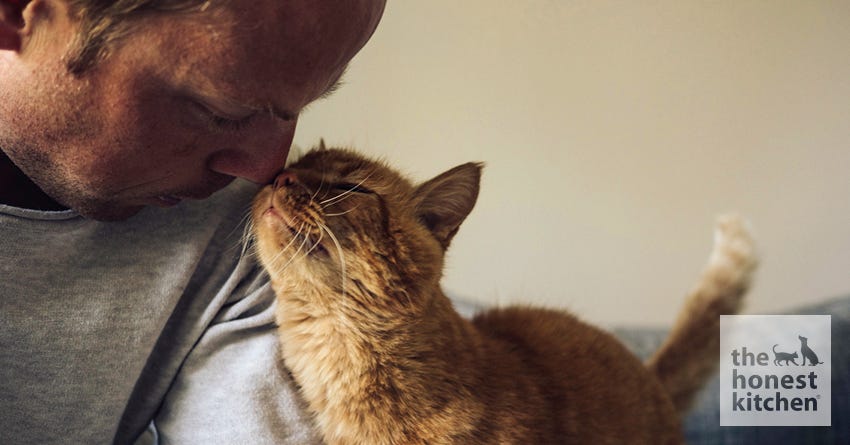Cats are wonderful companions, but as with all friends there can be some confusion.
This is especially true during cross-species communications, so let's take a look at seven cat behaviors that are sometimes misunderstood.
The Nose Poke
Cats nose poke (gently touch their nose to the other's nose) only trusted friends, be they feline, human, canine, or equine. A nose poke leaves the cat vulnerable as he must be close to the other entity to do it, therefore it is offered sparingly and only to the best of friends. Behaviorists vary on ideas as to why cats do this. Some suggest its related to the cat's scent glands; scent glands release scent when rubbed and the nose poke is a gentle touch. A word of warning, though. Never force a nose poke. This communication needs to be initiated by the cat. If you try to force it, the action could be viewed by the cat as aggressive and you could be scratched or bitten.
The Face Rub
A face rub, unlike the nose poke, is both a greeting and a way to claim ownership. This claim is not dominant or possessive, however, as much as it is sharing scent and showing the world that the two of you belong together. Cats will rub their face and body (side rub) but the face has many scent glands, so much of the rubbing is with the face. These glands are located around the mouth and chin, along the sides of the face, and around the ears. This communication is not one way, however. When you pet your cat, rub his ears, and scratch under his chin, you are leaving your skin dander and skin oils on your cat, too.

©istockphoto/cunfek
Comfort in High Places
When someone adopts one of my foster kittens I always ask if they have a cat tree. Most adopters have one but sometimes the potential adopter looks confused. I'm often asked why they need cat furniture when they have a home full of furniture. I explain the cat tree is great for teaching a kitten where scratching and clawing is allowed (versus using your furniture for this), but the tree also provides the kitten a high, safe place.
The Head Bunt
Some cats give head bunts when they're hungry, others when they just want your attention. With my cat, Scottie, the head bunt isn't a push; it's a bump, and every cat may adapt it for his or her own uses. If you don't pay attention, for example, your cat may try a harder push to see if that gets your attention. The head bunt is usually an attention-getting behavior. Cats do it to get you to find them faster, and your cat could head bunt you for petting, to get you to play, or for cuddles. For most felines, high hiding places are safer than hiding places that are lower. In a low spot the cat could be disturbed by the family dog, children, or even the evil vacuum cleaner. In a high spot such as on a cat tree, on the back of the sofa, or the top of the refrigerator, the cat can see what's coming. When your cat is in one of these spots, leave her alone. She'll come down when she wants your attention.
Kneading and Sucking

Kneading is an action leftover from when the cat was a nursing kitten. Pushing with the front paws and then releasing, alternating paws, and flexing the toes, is a natural part of nursing and stimulates milk release. Many kittens will continue to do this after weaning and it is usually a comforting action. Kittens who have been taken from their mom too young will knead even when being fed with a bottle. Many cats will continue to knead even as adults. It usually occurs when the cat is being petted on a lap or in your bed as the kneading is associated with feelings of warmth and comfort. Unfortunately, as a kneading cat flexes his toes, the claws come out, turning kneading into a painful activity for the owner. Just pull a blanket, wrap or sweater over your skin so your cat can continue to knead but your skin is protected. Some cats as they knead will also suck on a piece of fabric (blanket or your shirt or sweater). This is also related to nursing behavior and is usually seen in kittens who were removed from momma too soon. If I take in foster kittens who are two or three weeks old, they will often knead and suck when being petted. Many will grow out of the behavior but some will continue to do this as they grow up.
Shop Cat Food Best Sellers
Kicking
Kirk, my orange tabby cat, loves to disembowel (or pretend disembowel) stuffed toys, and every once in a while, one of my shoes. He'll be playing, grabbing with his teeth and front paws, and then will begin kicking ferociously with his back legs. This play fighting has its origins in hunting and defensive behaviors, as those kicking back legs can do some damage if the cat is hunting or defending herself from attack. Some cats, however, will use those back legs against a person who is playing too hard. If while playing with your cat, you roll her over on her back and pin her or play with her belly, don't be surprised if she begins to kick. She may be feeling threatened and feels that she needs to defend herself. Over stimulation in play or during petting can also cause a cat to use those back legs. Cats who can only take short petting sessions are more likely to kick than cats who melt into your hands. The cat who is kicking is trying to communicate that she's had enough.



